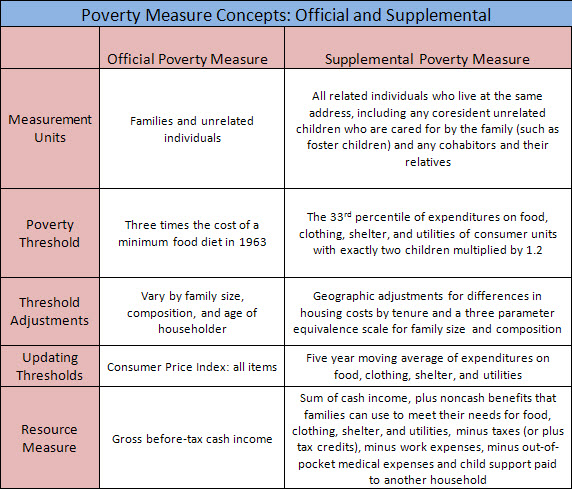What is the Supplemental Poverty Measure and How Does it Differ from the Official Measure?
What is the Supplemental Poverty Measure and How Does it Differ from the Official Measure?
Note: This is an updated version of a blog that ran last year. It provides important information on the differences between the official and supplemental poverty measures.
Since the publication of the first official U.S. poverty statistics in 1964, there has been a continuing debate about the best way to measure income and poverty in the United States.
In 2009, an interagency group recognized that alternative measures could provide useful information to the public and asked the Census Bureau, in cooperation with the U.S. Bureau of Labor Statistics, to develop a new way to measure poverty. The Census Bureau will release the latest supplemental poverty measure statistics tomorrow.
The official poverty measure compares an individual’s or family’s before-tax cash income to a set of thresholds that vary by the size of the family and the ages of the family members. These official poverty calculations do not take into account the value of in-kind benefits, such as those provided by nutrition assistance programs, and housing and energy assistance. Nor do they take into account regional differences in living costs or expenses, such as housing.
However, the supplemental poverty measure takes into account family resources and expenses not included in the official measure as well as geographic variation. First, it adds the value of in-kind benefits that are available to buy basic goods to cash income. In-kind benefits include nutritional assistance, subsidized housing, and home energy assistance. Then it subtracts necessary expenses for critical goods and services not included in the thresholds from resources. Necessary expenses that must be subtracted include income taxes, Social Security payroll taxes, child care and other work-related expenses, child support payments to another household, and contributions toward the cost of medical care and health insurance premiums.
Thresholds used in the new measure are derived from Consumer Expenditure Survey data that show how much people spend on basic necessities (food, shelter, clothing and utilities) and are adjusted for geographic differences in the cost of housing. The new thresholds are not intended to assess eligibility for government assistance.
This week’s report will compare 2012 supplemental poverty estimates with 2012 official poverty estimates for numerous demographic groups. It will also provide state-level supplemental poverty statistics using three years of Current Population Survey Annual Social and Economic Supplement data and compare 2011 supplemental poverty statistics with 2012 statistics. In addition, the report will examine the effect of excluding individual resource or expenditure elements on supplemental poverty rates.
The technical design of the supplemental poverty measure draws on the recommendations of a 1995 National Academy of Sciences report and the extensive research on poverty measurement conducted over the past 15 years.
For more details on the new measure, please see the technical appendices of the November 2011 and November 2012 reports or the technical webinar presented in November 2011.
Publication
Publication






